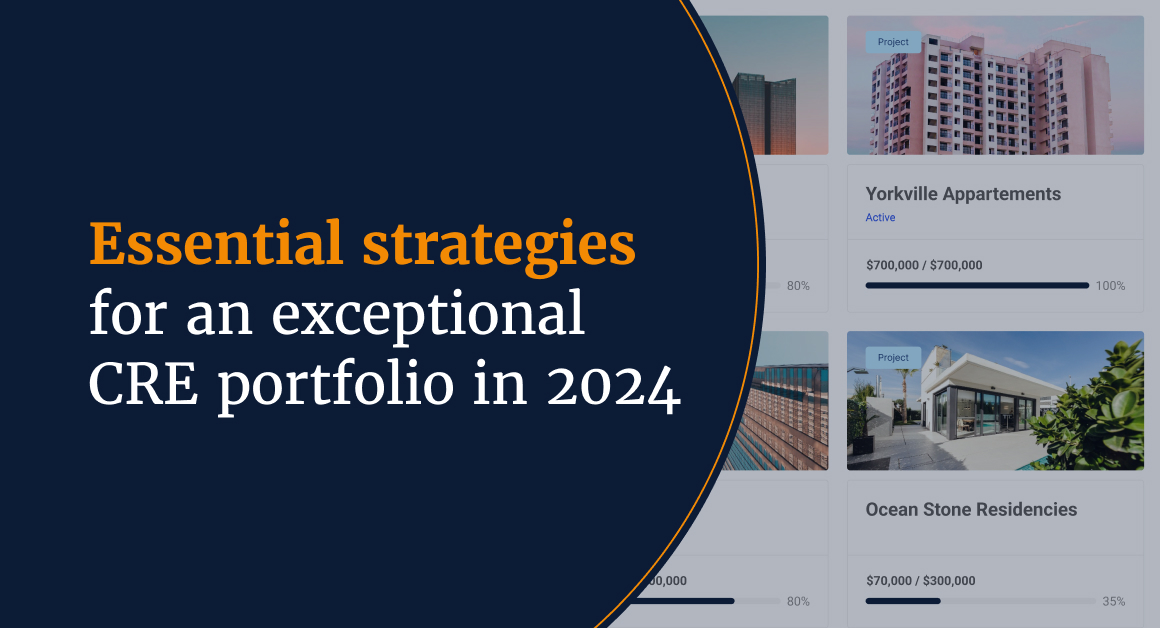What is a CRE portfolio?
Simply put, a commercial real estate portfolio is the collective real estate investment assets owned by an individual, group of investors, or institution. A CRE portfolio is focused on income-generating properties and real estate assets instead of residential properties.
Investment assets typically found in a commercial real estate portfolio may include real estate investment trusts (REITs), development projects, and debt instruments. A real estate portfolio balances risks and rewards for steady growth.
Commercial real estate portfolio optimization process
In the competitive CRE investment market, defining clear and specific objectives and developing a strategy to move toward them is crucial. Investors should consider whether they seek regular income or a combination of both. Risk factors are equally important as they guide decisions on financing and property type.
A strategy addressing market conditions and analyzing potential returns should be developed. A diversified portfolio is critical in mitigating risk and riding out market fluctuations. Here are some essential things to consider:
Defining investment goals and objectives
- Specificity: Investors should set clearly defined goals, including desired annual income, a targeted rate of return, property type preference, and geographic location.
- Risk tolerance: Understanding the risk level the investor is comfortable with is essential. Some investors seek lower-risk assets that provide consistent cash flow, while others are risk-tolerant and willing to take on more risk for a higher return capacity.
- Tax considerations: A CRE investor should consider tax implications, including capital gains upon the sale of a property or the benefits from depreciation deductions.
Aligning investment strategy with objectives
Fluid market conditions and fluctuations in interest rates demand vigilance in maintaining alignment between objectives and strategy.
- Market research: Consistently analyze market trends, vacancy rates, and economic indicators to inform strategy adjustments.
- Financing strategies: Tactics to mitigate changing or adverse financing conditions might include securing favorable financing rates or using alternative financing methods such as partnerships or crowdfunding.
The current state of portfolio assessment
A comprehensive review of existing properties in the portfolio should include a financial assessment targeting rental income, occupancy rates, expenses, and overall profitability. Conduct a physical inspection of all properties to evaluate maintenance needs and any renovations that may be necessary.
Local market conditions for existing properties in the portfolio should be analyzed considering inventory and demand, rental trends, vacancy rates, and economic indicators. Review tenant profiles, lease agreements, quality of tenants, and potential risks related to tenant turnover.
The future state of portfolio assessment
Future market trends and changes in demand for future commercial properties should be taken into account, along with factors such as population growth, economic development plans, infrastructure projects, and industry trends.
A forecast of rental growth rates, potential property increases or decreases, and opportunities for value-add strategies should be conducted.
Strategies for building a strong CRE portfolio
The basis of a strong CRE portfolio rests in proactive management and strategic decision-making. Seasoned and successful commercial real estate investors understand that a robust CRE portfolio requires careful consideration and the implementation of effective investment strategies to foster strong returns. Some of these strategies are discussed as follows:
Scenario planning as a strategy
Although no investor can predict the future, scenario planning is a tactic that can be employed as a proactive approach to strategic decision-making in commercial real estate investment.
It involves visualizing various impending market conditions, creating a narrative of the future, and preparing for events that could impact an investment portfolio.
With scenario planning in their investment process, investors can better understand and traverse uncertainties and optimize their commercial real estate portfolios.
Exit strategies
Knowing when it’s time to get out or restructure an investment is a strategy that must be put in place and implemented when necessary. This may include selling, refinancing, or redevelopment. It’s also important to anticipate liquidity constraints and market cycles when planning exit strategies.
Monitoring market conditions and property performance will ensure that an optimal time for exiting the investment is identified and carried out.
Conduct due diligence
Due diligence is an investment strategy that shouldn’t be overlooked. It’s a critical step in building a successful real estate portfolio and will highlight the risks and opportunities associated with potential property purchases.
By conducting a thorough due diligence strategy, investors can minimize risks, maximize returns, and make informed decisions in building a CRE portfolio that delivers positive long-term returns.
Here are just some of the ways due diligence plays a key role in the investment strategy:
- Property evaluation: A comprehensive property evaluation should include a financial analysis, market research, and a physical inspection.
- Legal and compliance: Verify the property’s ownership through a title search, ensure that the property is appropriately zoned for intended use, and conduct an environmental assessment to confirm that the property is free from contamination.
- Financial projections: Develop financial models to estimate potential returns on investment and perform a sensitivity analysis to understand how vacancy rates, rental rates, and operating expenses could impact return on investment.
Decide on how to fund an investment
There are many ways to fund a CRE investment, depending on the investor’s goals and strategy. The following are a few examples of the most common.
- Commercial mortgage: Similar to a residential mortgage, this type of mortgage is tailored for commercial properties. Interest rates are dependent on the investor’s financial profile, the lender, and property type.
- SBA loan: The Small Business Association loans are used for owner-occupied commercial real estate. These loans require a smaller down payment and offer competitive terms.
- Private lenders: Private or hard money lenders offer a quick turnaround, but that comes with a higher interest rate and shorter terms. Investors who may have trouble qualifying for a traditional loan or need to act fast pursue private lenders.
- Seller financing: Many times, sellers are willing to finance part of the purchase, which can involve a smaller down payment. Investors negotiate directly with the seller for the terms of the loan.
- Equity financing: Involves partners or other investors from whom an investor can raise money. These outside investors become co-owners of the properties.
- Real Estate Investment Trusts (REITs): A REIT is like a stock an investor can buy and sell on major stock exchanges. REITs offer liquidity and make it easy to buy and sell shares. Returns come in the form of dividends and potential appreciation of share value.
- Real estate syndications: When multiple investors pool their funds to purchase a property, it’s known as a real estate syndication. A syndicator or a sponsor manages the fund. Participants can act as passive or active investors. A passive investor provides capital and relies on the expertise of the syndicator to manage the property. An active investor usually has experience or expertise and finds the deal, raises funds, and manages the property.
Diversification strategies for building a CRE portfolio
A healthy and prosperous commercial real estate portfolio is built on diversification, which helps reduce overall portfolio risk and increases stability. Here are some of the essential components of a diversified CRE portfolio:
Property type diversification
Choose a mix of property types, which might include office buildings, retail centers, industrial warehouses, multifamily, hotels, and mixed-use developments. Remember that these property types have varying risk profiles, so diversifying across the board spreads risk.
Geographic diversification
Investing in properties in different regions or markets helps to mitigate risks associated with local economic downturns or market-specific risks. Diversification across various cities and states can capture changing market dynamics and economic conditions.
Market sector diversification
Just as property types perform differently, market sectors within each property type also fluctuate. Consider diversification across different market sectors. For example, an investor in the retail sector might diversify between shopping malls, strip malls, and stand-alone retail buildings.
Development and acquisition property diversification
Maintain a balance between development projects and acquisitions of existing properties. Higher-risk development projects offer the potential for higher returns but can be offset with acquisitions of stabilized properties, which provide cash flow and stability to the portfolio.
Investment structure diversification
Different investment structures such as direct ownership, real estate investment trusts (REITs), real estate funds, and syndications all offer the means to diversify a CRE portfolio. Each structure provides a unique benefit and risk profile that promotes portfolio equilibrium.
Benefits of including commercial real estate in your investment portfolio
Commercial real estate investing provides abundant benefits, making it an attractive addition to a CRE portfolio for investors seeking income, growth, and long-term wealth accumulation. The following are some of the benefits that commercial real estate investors enjoy:
Stable and predictable income
Whether a high-rise office building or a retail outlet in a strip mall, commercial properties generate rental income from tenants and provide a steady and predictable cash flow.
Long-term leases coupled with established tenants often result in a steady income stream that makes commercial real estate a solid source of passive income.
Capital appreciation
When well-planned objectives and strategies are set in place, capital gains are often realized upon the sale of commercial properties. Other factors, such as location, market demand, property improvements, and economic conditions, can also contribute to property value appreciation.
Portfolio growth and wealth-building
Commercial properties have the potential to bring in income from long-term leases and property appreciation, which can contribute to long-term wealth accumulation and the enhancement of portfolio returns.
Tax benefits
CRE investors enjoy many tax advantages that may offset the burdens of taxes incurred on other investments. Tax benefits include accelerated depreciation through cost degradation, 1031 exchanges, and depreciation deductions, which can offset rental income, reduce taxable income, and provide tax savings.
Hedge against inflation
Inflationary pressures work to the advantage of commercial real estate investors. Increasing inflationary trends can cause property values to rise and rental income to increase. Leases often include rent escalations linked to inflation and create a hedge against the declining value of the currency.
Ability to apply leverage
One of the great benefits of incorporating real estate in a CRE portfolio is leverage through financing. Real estate investors can use a combination of equity and debt to acquire property, increasing potential returns. The ability to control a more considerable asset with a small amount of capital is rarely found in other comparable investments.
Tangible asset
Real estate investments are tangible assets investors can see, touch, and experience more control over. Investors can also make decisions regarding management, renovations, and lease negotiations.
Portfolio balance and risk management
Commercial real estate can balance the risk-return profile in a CRE portfolio. It counterbalances the volatility of stocks and bonds, reducing overall portfolio risk.
Risks of investing in CRE and how to deal with them
Although investing in commercial real estate involves risk, having a carefully planned and well-managed portfolio can outweigh some of the risks and offer the potential for capital appreciation and long-term wealth building.
The table below provides an overview of each risk, its description, and mitigation strategies for investors building a CRE portfolio.
| Risk Type | Description | Mitigation Strategies |
| Liquidity Risk | An investment asset that can’t be sold quickly and at fair market value is considered a liquidity risk. | Consider diversification to balance the portfolio with varying liquidity profiles. |
| An adequate cash reserve or line of credit is always a good defense against unexpected expenses and an excellent offense to capture investment opportunities. | ||
| Include publicly traded REITs or real estate funds with liquidity provisions in your portfolio. | ||
| Economic Risk | Exposure to economic downturns affecting property values, occupancy rates, and rental income. | Thorough market research and diversification in property types and sectors with strong economic fundamentals can reduce risk during economic downturns. |
| Choose properties with stable cash flow and long-term leases. | ||
| Project Risk | Risks associated with development or renovation projects can include cost overruns, delays, and construction issues. | Conducting extensive due diligence on project details and analyzing the developer’s track record, financials, and project plans can lessen risk. |
| Contract with builders willing to enter into fixed-price contracts and set aside emergency funds for unforeseen expenses. | ||
| Unplanned Capital Call Risk | Risk of needing to provide additional capital beyond initial investment. | Gain an understanding of the investment terms and capital call obligations. |
| Ensure that adequate funds are available to meet unexpected capital calls. |
The bottom line
Defining objectives, strategic diversification, and proactive management are essential ingredients in developing a successful commercial real estate portfolio. Along with that, meticulous due diligence and proactive asset management shouldn’t be overlooked. Ultimately, aligning investment objectives with market opportunities and leveraging data-driven decision-making produces a well-balanced portfolio set for long-term success.










